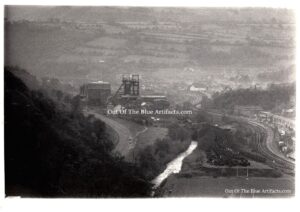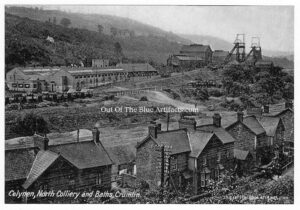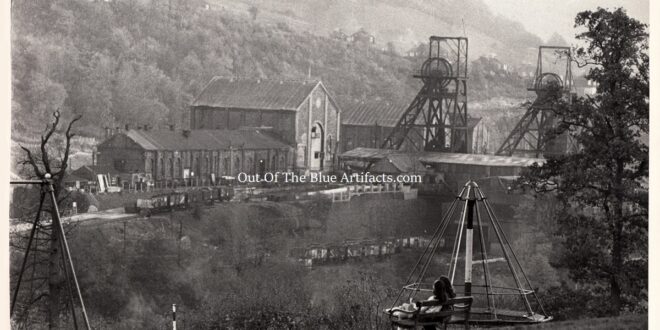 North Celynen Colliery.
North Celynen Colliery.
The North Celynen Colliery was sunk by the Newport Abercarn Black Vein Steam Coal Company between 1908 and 1916.
In January 1908 at a meeting in connection with a proposed recreation ground at Crumlin, the councillors heard that Kay Field, one of the options for a park, was out of the question as it had been promised to the Newport Abercarn Coal Company for future planned sinking purposes.
The Sinking.
On Monday 17th of January 1910, at a meeting of the Western Valley’s Sewage Board at the County Council Offices at Newport with Mr Benoni Stacey as chairman; Alderman Mr Thomas and Mr Bowyer. The resident Engineer Mr J. F. Jupp reported that the Newport Abercarn Black Vein Steam Coal Company were sinking new pits on land near Dock Quarry between Crumlin and Newbridge. The company produced plans and asked permission to tip the waste on land under which lies a sewer at a length of half of a mile.
In July 1910 arrangements were being made for the sinking.
The Merger of the Colliery Companies.
In July 1911 the Newport Abercarn Black Vein Steam Coal Company merged with the Ebbw Vale Steel, Iron and Coal Co.
In August 1911 during the sinking of the North Celynen Colliery an accident occurred when a crane used to wind the bowk up and down the shaft, toppled over. The crane was just about to lower the shot-firer in the bowk as it up-ended. The shot-firer scrambled out, though the driver Mr Herbert Sims aged 24 from Crumlin was caught in the machinery as it fell and was severely injured.
Dr Ryan Colliery Surgeon.
In October 1911 Dr Ryan was made surgeon to the Crumlin Navigation and the North Celynen Colliery.
The New Shaft.
In January 1913 the Newport Abercarn Black Vein Steam Coal Company announced that a new shaft was being sunk at the North Celynen.
The First Coal Raised.
On Monday 28th of June 1915, it was announced that the first coal was raised at the North Celynen Colliery. It stated 100 men were employed at the pit.
In July 1920 at a council meeting, it was announced that the council would approve the construction of huts for the pit-sinkers to live while they sank the second shaft at the North Celynen Collieries. The huts were to contain the sinkers and consisted of a kitchen, mess-room and sixteen bedrooms. The Newport Abercarn Company told the council that there was no accommodation in Crumlin and temporary places was needed for the contractors.
The Ballot for the Pithead Baths.
In July 1929 a Ballot was held for the construction of a pithead baths. The votes cast were as follows – 642 votes for and 525 votes against.
 The Opening Ceremony of the Pithead Baths.
The Opening Ceremony of the Pithead Baths.
On Saturday 2nd of July 1932, the North Celynen Colliery Pithead Baths and a new lamproom were officially opened. The baths (as seen in the image right) which was described as the most modern and commodious in South Wales was erected at a cost of £24,000 made provision for 1,344 men were erected under the Miners Welfare Scheme and was constructed by Messrs W. Miles & Sons, contractors of Ebbw Vale.
The opening ceremony was conducted by Mr W. C. Evans, who was manager of the colliery and the chairman of the Pithead Baths Committee. Mr Evans paid tribute to Mr Harry Williams, who had been chairman of the miner’s lodge and largely responsible for the baths being built.
The North Celynen Colliery Pithead Baths were opened by Lady Beynon, M.B.E. wife of Sir John Beynon, Bart., C.B.E. the managing director of the Ebbw Vale Steel, Iron and Coal Company Ltd. Miss Beynon (Daughter) later officially opened the new lamproom. Sir John Beynon spoke of how, as a child he had been taken by his father to the “Cutting of the Sod Ceremony” at the South Celynen Colliery and said he hoped that the North Celynen Colliery would be one of the largest coal producing collieries in Wales.
Mr W. Miles, the contractor presented Lady Beynon with a golden key though before Lady Beynon opened the door to the baths she also said of “How 59 years ago, the first sod at the collieries was cut by one of the dearest little old ladies that ever lived, her husband’s mother”. She said, “She was glad to follow in her footsteps and to have the honour of opening the first Pithead Baths in the Newport Abercarn Group of collieries”.
The Official Opening of the Lamproom.
Later Miss Beynon opened the new lamproom and was presented with a modern electrical lamp and an oil safety lamp as souvenirs of the special occasion. The company of 250 present at the ceremonies were afterwards conveyed in motor cars and buses to the Abercarn Welfare Pavilion for tea.
There was a huge gathering of dignitaries, guests and other spectators, (too many to list but available on request).
The Contractor and Architect.
The contractor was Messrs W. Miles & Sons of Ebbw Vale.
The New Baths Extension and Canteen.
It seems that even though the pit-head baths were one of the largest of its kind when it was originally constructed in 1932, it was thought necessary to build it even larger still. In 1933-34 plans were put in place to build an extension including a new idea of a pit canteen. The construction of both buildings went ahead.
The Official Opening of the Baths Extension and Canteen.
On Saturday 8th of September 1934, the North Celynen Pithead Baths new extension costing £16,000, was officially opened. The baths now had provision for 2,184 men and bath cubicles numbering 230. There were 1,960 men employed at the colliery and there was ample provision for additional men to be signed on. Mr Ben Owen (Agent) stated that “The canteen built adjoining the baths was the first of its kind in South Wales”. Mr Owen said “The canteen sales profits would be used to reduce the men’s subscriptions towards the baths”. The total cost of the baths, new extension and the canteen was £49,000. Mr Harry Williams the chairman of the works committee presented Lady Beynon with a gold wristwatch and referred to her as a great social worker. Others who made speeches on the day were as follows – Mr Trevor L. Mort, general manager of the Ebbw Vale Co; Mr Opton Purnell, miners’ sub-agent; Mr W. Robbins, vice-chairman of the lodge; Mr D. Evans the secretary of the management committee and Mr George Yearsley the lodge secretary:
In January 1935 it was announced that the canteen profits had been enough to provide each of the thousand or more men who use the baths with one pound of soap and a towel. The money was taken from the profits of the canteen where tea and cocoa were provided.
In February 1936 a deputation from the Abertillery and District Hospital Board waited on a general meeting of the North Celynen Colliery Lodge and asked for a donation towards the purchase of a new “X-Ray Control Table”. Later the deputation was informed that the lodge had decided to give £75 the total sum required for the purchase of the table. It was understood the table was inscribed with “Presented by the North Celynen Colliery workmen”. Mr Harry Williams was at the meeting and stated the feeling was that it couldn’t go to a more deserving cause. Members of the hospital board included the following – Mr W. Higgins (Chairman); Mr Walter Davies (Vice Chairman); Alderman Mr W. T. Williams and the (Secretary of the Hospital):
Mr T. A. Rogers.
In 1937 Mr T. A. Rogers was the manager at the North Celynen Colliery.
I am not sure of the exact closure date.
Photographs Copyright Information.
The North Celynen Colliery photographs were taken by Wrad on the 4th of November 1970.
The images were used by the South Wales Echo in connection with the miners’ strike in 1972 and 1976 and indicated by written instructions on the reverse of the images.
Copyright – TOPIX, The Thompson Organisation Ltd Picture Service. Thompson House, 200 Gray’s Inn Road, London. WC1.
Points of interest – It was well documented that many accidents and deaths occurred at the South Celynen Colliery and from the start of sinking at the North Celynen things didn’t seem any different at this pit though to a less greater extent of deaths! Some of the early fatalities that were reported at the North Celynen Colliery are as follows –
1914
May – Mr William Tedstone, aged 31. Pumpsman. Death caused by a burst steam pipe in the sinking pit Lodge Room, a sort of pump house in the shaft:
1916
June – Mr Emrys Thomas Williams, aged 17. Death caused by a roof fall:
1920
October – Mr George Coles, aged 16. Door Boy. Death caused by being crushed by a journey of drams:
1921
February – Mr Shipton. Sinker. Death caused by electrocution while fixing lights on a sinking platform in the shaft:
1924
March – Mr William Raymond Wooley. Death caused by being crushed by a runaway journey of drams from the Gloucester Parting. Full story below:
1924
July – Frederick Charles Morgan, aged 47. Pitman. Death caused from falling 1,200′ feet down the shaft:
1926
April – Mr Henry John Froude. (Accidental death recorded). Full story below:
1928
March – Mr William Rosser Brewer, aged 26. Death caused from being struck by machinery of the winding engine:
1929
July – Mr James Gingell;
August – Mr Albert John West, aged 33. Death caused by a roof fall:
1930
November – Mr Albert John Maiden, aged 14. Collier’s helper. Death caused by a roof fall:
1932
November – Mr John Francis Hope, aged 15. Death caused by a roof fall:
1936
May – Mr David Jones, aged 66. Death caused by a roof fall;
June – Mr John D. Jones, aged 50. Death caused from being crushed by a journey of drams;
September – Mr Bert Williams, aged 21. Death caused by a roof fall:
1937
March – Mr William George Watkins, aged 18. Death caused by a roof fall;
May – Mr William John Herbert, aged 24. Death caused by a roof fall. Mr Herbert lived at Blaina:
1938
April – Mr Henry Dyer, aged 59. Death caused by a roof fall:
1945
July – Mr Thomas Griffiths, aged 30. Death caused by a roof fall. Mr Griffiths lived at 14 Brynheulog Terrace Llanhilleth. Mr Horace Rees, aged 30. Death caused by a roof fall. Mr Rees lived at 59 Rectory Road, Crumlin. Mr Griffiths and Mr Rees worked together and were caught under the same roof fall. Both men died on Wednesday 18th July 1945: Mr John Beech was injured in the same roof fall although survived.
1976
March – Mr Michael John Filer, aged 27.
March – Mr Edward Jones, aged 40. On the 27th of March 1976, Michael John Filer and Mr Edward Jones died in a roof fall. Michael John Filer lived at Evelyn Street, Abertillery. Mr William Edward Jones lived at North View, Freeholdland, Pontnewydd.
Further information on the above fatalities.
In March 1924 Mr William Raymond Wooley. Death caused by being crushed by a runaway journey of drams from the Gloucester Parting. The 23 drams were in the process of being spragged when the runaway occurred. Also injured in the accident was Mr David Alfred Lewis, Mr William Haines and Mr George Parker. Mr Wooley’s father who was working at the Llanhilleth Colliery was also injured in an accident the same day as his son was killed. Mr David Alfred Lewis who was seriously injured was taken to the Royal Gwent Hospital, Newport and was placed in a bed next to his own brother who was in hospital having an operation:
The Carnegie Hero Fund Rescue.
On Monday 8th of March 1926, about 10 o’clock in the morning, Mr Albert Holland aged 20 from Crumlin, Mr Henry John Froude, aged 19 from No2 Caefelin Street, Llanhilleth and Mr Edwin “Ned” Beecham of Pontllanfraith were employed on the No.2 Conveyor Dump Heading in the South West District of the North Celynen Colliery engaged in putting up timbers. Before they could finish a fall occurred. The roof crashed and buried both Mr Froude and Mr Holland, Mr Beecham was thrown clear of the fall and escaped unhurt. Their workmates – Mr Hamilton Hale (of Mitre Street, Abertillery) and Mr Harry Williams who worked close by came to their aid. They were later joined by the overman Mr Arnold Knight, the manager Mr R. Rutherford, the under-manager Mr Brewer, Mr Ben Owen colliery agent and Dr’s Ryan and Morgan.
The rescuers worked hard to clear the debris, although the roof was falling continually and it wasn’t until 2 o’clock that they managed to free Mr Holland who sustained only slight injuries and shock. They continued to try and free Mr Froude. Work continued until his head was visible, at this point stimulants were fed to Mr Froude through a tube by three brothers called Coleman under the direction of Dr Ryan. The rescuers were later joined by Mr John Graham Cordey of Henwain Street, Blaina, Mr H. McVicar of the Ebbw Vale Company, Mr Sam Graham, secretary of the lodge, Mr Opton Purnell, miners’ sub-agent and Dr’s T. A. Gregg and Grey. As soon as the help arrived a second fall occurred and at that point Mr George Coleman one of the ambulance men protected Mr Froudes head from falling stones by putting his leg over his face, as a result he badly injured his leg and had to be taken out. At 8.30pm Mr Froude was freed from the fall and taken home, sadly he passed away from his injuries on the Tuesday night.
The inquest heard that over 20 drams of roof fell on the men in the first fall, about 20 to 30 tons.
On Tuesday 29th of June 1926, it was announced that the King was to award the Edward Medal in silver to Mr George Coleman and the Edward Medal to both Mr John George Cordey and Mr Samuel Graham, employed by the Newport Abercarn Black Vein Steam Coal Company Limited. The announcement was issued in the London Gazette which detailed the circumstances for which the award was made, as follows – “On March 8th, 1926, in the course of operations at the North Celynen Colliery in Monmouthshire, a fall occurred almost completely burying two colliers who were at work” the report went on to recall the events that followed. It concluded in stating that “Messrs Graham and Cordey acted unselfishly and even though their lives were in danger they stayed and helped in the release of the trapped men and both exhibited courage of a very high order”.
After the announcement of the awarding of medals to the named gentlemen there were a few letters of bemusement and condemnation on the award procedure, many said the rescue party contained six men with many officials and management also helping, so why choose just three men to be officially recognised? It was also said that the two workmates who was there at the scene an helped from the outset of the fall Mr Hamilton Hale and Harry Williams were not even mentioned.
A sub note from the Editor of the South Wales Gazette stated, “They believe six names were submitted but they understand that the number was reduced to three, possibly done to comply with Home Office regulations”.
In January 1927 Mr George Coleman was reportedly the recipient of a Carnegie Hero Fund Bronze Medal and it was announced that he qualified for financial aid to help towards him becoming a motor engineer. Mr Coleman was seriously injured in the rescue and the Bronze Medal was the highest award which the trustees of the fund could grant. Later Mr John Graham Cordey was also recognised by the Carnegie Hero Fund, was granted an Honorary Certificate and £20 for assisting in the rescue.
On Tuesday 25th of January 1927, at the opening of the council offices, Mr George Coleman, Mr Samuel Graham and Mr John G. Cordey were officially honoured for their bravery and part in the rescue of Mr Holland and Mr Froude on March 8th, 1926. Mr Graham and Mr Cordey were presented with the trust’s certificates and a cheque, and Mr Coleman with a medallion and financial aid.
In August 1934 Mr John George Cordey sadly died. Mr Cordey retired to Gilwern through ill health, whilst out walking he fell over a quarry. It was announced the wife of the late Mr Cordey was to receive an augmentation to her pension as her husband was in receipt of the Carnegie Hero Fund payments.
The Carnegie Hero Fund.
The Carnegie Hero Fund was established in Great Britain in 1908. The aim of the Carnegie Hero Trust Fund was to recognise civilian heroism and give financial assistance to people who were injured or to the dependents of people who have been killed in attempting to save another human life in peaceful pursuits. The medals awarded by the fund were bronze, about 3″ inch in diameter and struck by the Simons Brothers Co, Philadelphia, USA.
Hungry Horses.
In a news report from the 1930’s it was stated that the horses at the North Celynen Colliery, although very well fed, they did like to eat small lumps of coal from the drams, it was believed that they must have been attracted to some element found in the coal.
 Out Of The Blue Artifacts A Library of a lifetime of collecting
Out Of The Blue Artifacts A Library of a lifetime of collecting
